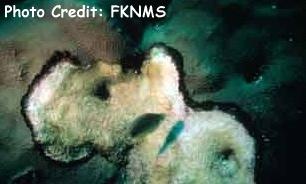
By Bob Goemans


Dark red or black slime/grease-like growths are cyanobacteria, of which probably a "Oscillatoria" species is the most commonly seen. It is photosynthetic and can rapidly cover wide areas, especially in nutrient rich environments. Most of the time it's considered a nuisance because it can get out of control "very" quickly. However, some very small patches on the substrate should not be cause for alarm as it is one of the earliest microbial colonizers. Only mat-like growths should be removed.
As with "some" forms of green hair algae, once it begins to form mat-like growths it is capable of becoming somewhat independent of bulk water nutrients. The reason for this is that mat-like growths become a barrier to normal diffusion gradients in rock and sandbeds. That "barrier" negatively affects the normal microbial processes in the substrate they are covering and nearby areas. This benefits the growth of the alga/cyanobacteria structure because the conditions in the below substrate then supply the growth some of its nutrients. And even mats seen on aquarium sides panels are capable of supplying itself some of the needed nutrients once the growth becomes extensive.
Cyanobacteria may sometimes be confused with brown "grease-like" algae, which is sometimes stringy with bubbles of gas trapped inside. These slime-like growths are usually either a very bad case of a diatom or dinoflagellate alga. Both can cover substrate and living animals rapidly.
Another slime-like alga in the Kingdom Monera is Phormidium corallyticum. It has been identified as the cause of stony coral and gorgonian Black-band disease. Once this alga toxic metabolites get near coral tissue, the tissue begins dying. Dead tissue then becomes a food supply for this and other opportunistic bacteria. Further necrosis spreads and as more tissue is affected, it often leads to the loss of the specimen.
The following recommendations will often greatly help resolve unwanted cyano problems.
* Increase water flow to remove dead spots/low current areas. Use a wavemaker to generate surge, which can prevent the settling of detritus in normally low flow areas, thereby eliminating concentrations of organic matter.
* Increase or provide efficient protein skimming to help remove the organic nutrients this pest needs to get started and reduce if necessary nitrogen laden compounds such as ammonium and nitrate, along with any excessive phosphate content.
* Vacuum any/all existing cyanobacteria mats quickly and as often as necessary.
* The antibiotic Erythromycin sulfate or Tetracycline will kill cyanobacteria. Even though these chemicals may eliminate this unwanted pest the first time around, further problem blooms may become more resistant to the drugs. It is really much wiser to get to the root of the problem than to put antibiotics into the aquarium. Bear in mind that antibiotics negatively affect system biological filtration.
* Siphon out the affected areas' upper quarter inch of sand and replace with new sand. Often this removes an area where there was a concentration of organic material.